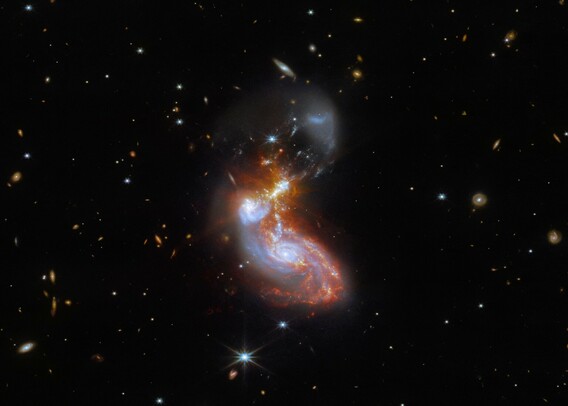M F ∆ W :verified: · @fitriabwahid
45 followers · 355 posts · Server mindly.socialThe James Webb Space Telescope #JWST has captured a pair of #galaxies distorting each other as they merge in a great galactic get-together.
The ongoing cosmic collision imaged by Webb is known as II ZW 96. It is roughly 500 million light-years from #Earth and located in the #constellation #Delphinus, according to a Nov. 30 #NASA statement.
#astronomy #astronomytalk #astronomysociety #astronomyresearch #astronomyoftheday #astronomyatmastodon
#JWST #galaxies #earth #constellation #delphinus #nasa #astronomy #astronomytalk #astronomysociety #astronomyresearch #astronomyoftheday #astronomyatmastodon
Reymond Aguinaldo · @mondinspace
559 followers · 1367 posts · Server mastodon.social#ICYMI: Images of #IIZW96, a merging of two #Galaxies about 500 million light-years away from #Earth, were captured by the #JamesWebbSpaceTelescope. The swirling body of celestial activity is evolving in the #Delphinus #Constellation near the celestial equator.
#SpaceMastodon #Spacedon #Space #Astronomy #Astrodon #ScienceMastodon #Sciencedon #Science #Webb #JWST
#icymi #iizw96 #galaxies #earth #jameswebbspacetelescope #delphinus #constellation #SpaceMastodon #spacedon #space #astronomy #Astrodon #sciencemastodon #sciencedon #science #webb #jwst
Ethan Teng 🏳️🌈🏳️⚧️🇹🇼 · @citizen_astro
528 followers · 849 posts · Server mastodon.lolNGC 6934
Magnitude 8.83 globular cluster located 52,000 light-years away in the constellation Delphinus.
#astrophotography #astronomy #space #unistellar #citizenscience #ngc6934 #cluster #delphinus #caldwell47
#astrophotography #astronomy #space #unistellar #citizenscience #ngc6934 #cluster #delphinus #caldwell47
Ethan Teng 🏳️🌈🏳️⚧️🇹🇼 · @citizen_astro
528 followers · 849 posts · Server mastodon.lolNGC 7006
Magnitude 10.6 globular cluster located 135,000 light-years away in the constellation Delphinus. NGC 7006 appears in the science fiction novel Beyond the Farthest Star by Edgar Rice Burroughs, where it is used as a point of reference by the inhabitants of the planet Poloda to determine the approximate location of Earth.
#astrophotography #astronomy #space #unistellar #citizenscience #ngc7006 #cluster #delphinus #caldwell42
#astrophotography #astronomy #space #unistellar #citizenscience #ngc7006 #cluster #delphinus #caldwell42
Ethan Teng 🏳️🌈🏳️⚧️🇹🇼 · @citizen_astro
528 followers · 849 posts · Server mastodon.lolNGC 6905 Blue Flash Nebula
Magnitude 10.9 planetary nebula located 7,500 light-years away in the constellation Delphinus. It was discovered by William Herschel in 1784.
#astrophotography #astronomy #space #unistellar #citizenscience #ngc6905 #nebula #delphinus
#astrophotography #astronomy #space #unistellar #citizenscience #ngc6905 #nebula #delphinus
Ethan Teng 🏳️🌈🏳️⚧️🇹🇼 · @citizen_astro
528 followers · 849 posts · Server mastodon.lolNGC 6905 Blue Flash Nebula
Magnitude 10.9 planetary nebula located 7,500 light-years away in the constellation Delphinus. It was discovered by William Herschel in 1784.
#astrophotography #astronomy #space #unistellar #citizenscience #ngc6905 #nebula #delphinus
#astrophotography #astronomy #space #unistellar #citizenscience #ngc6905 #nebula #delphinus
Ethan Teng 🏳️🌈🏳️⚧️🇹🇼 · @citizen_astro
528 followers · 849 posts · Server mastodon.lolNGC 6891 Faint Ring Nebula
Magnitude 10.5 planetary nebula located in the constellation Delphinus.
#astrophotography #astronomy #space #unistellar #citizenscience #ngc6891 #nebula #delphinus
#astrophotography #astronomy #space #unistellar #citizenscience #ngc6891 #nebula #delphinus






